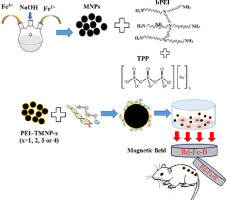Journal of the Taiwan Institute of Chemical Engineers ( IF 5.5 ) Pub Date : 2018-11-23 , DOI: 10.1016/j.jtice.2018.10.025 Ndumiso Vukile Mdlovu , Yun Chen , Kuen-Song Lin , Ming-Wei Hsu , Steven S.-S. Wang , Chun-Ming Wu , You-Sheng Lin , Kazuki Ohishi

|
Neuroblastoma accounts for about 6% of all cancers in children, with a 5–year survival rate of only 20–25%. The increased expressin of MYCN is associated with poor prognosis in patients with neuroblastoma. MicroRNA–34 (miR–34) may serve as a potential target for cancer treatment, owing to its function as an oncogene and tumor suppressor. In this study, positively charged magnetic nanocarriers comprising cross-linked polyethylenimine (PEI)–tripolyphosphate (TPP)–coated iron oxide nanoparticles (IONPs) were developed using co-precipitation method. These nanocarriers were capable of penetrating the cell wall and used for the delivery of miRNA–34a into the cells. The diffraction peak of synthesized magnetic nanocarriers at 2θ = 35.44° corresponded to that of magnetite (Fe3O4) (311), consistent with Joint Committee on Powder Diffraction Standards (JCPDS) database. The characteristic peaks at 3380, 1620, 2900, and 2840/cm corresponded to those of NH and − CH2− groups, indicating the successful coating of PEI. In addition, the small angle neutron scattering (SANS) spectra showed that the alternative magnetic field (AMF) triggered core heat generation, which softened the shells. The results of 3-(4,5-dimethylthiazol-2-yl)-2,5-diphenyltetrazolium bromide (MTT) assay revealed the nontoxicity of these nanocarriers to BE–2–M17 cells. The expression of miR-34a was raised and the expression of MYCN, the target of miR-34a, was significantly suppressed.
中文翻译:

多功能纳米载体可作为治疗神经母细胞瘤的潜在微RNA载体
神经母细胞瘤约占儿童所有癌症的6%,其5年生存率仅为20-25%。MYCN表达蛋白升高与神经母细胞瘤患者预后不良有关。MicroRNA–34(miR–34)由于其作为癌基因和肿瘤抑制物的功能,可能成为癌症治疗的潜在靶标。在这项研究中,使用共沉淀法开发了包含交联聚乙烯亚胺(PEI)–三聚磷酸盐(TPP)涂层的氧化铁纳米颗粒(IONPs)的带正电荷的磁性纳米载体。这些纳米载体能够穿透细胞壁,并用于将miRNA–34a传递到细胞中。在2中合成的磁性纳米载体的衍射峰θ = 35.44°对应于该磁铁矿(铁3 Ò 4)(311),与粉末衍射标准联合委员会(JCPDS)数据库一致。3380、1620、2900和2840 / cm处的特征峰对应于NH和-CH 2的特征峰−组,表示PEI包衣成功。此外,小角度中子散射(SANS)光谱表明,交变磁场(AMF)触发了核的发热,从而软化了壳层。3-(4,5-二甲基噻唑-2-基)-2,5-二苯基四唑鎓溴化物(MTT)分析的结果表明,这些纳米载体对BE-2-M17细胞无毒。miR-34a的表达被提高,miR-34a的靶标MYCN的表达被显着抑制。











































 京公网安备 11010802027423号
京公网安备 11010802027423号